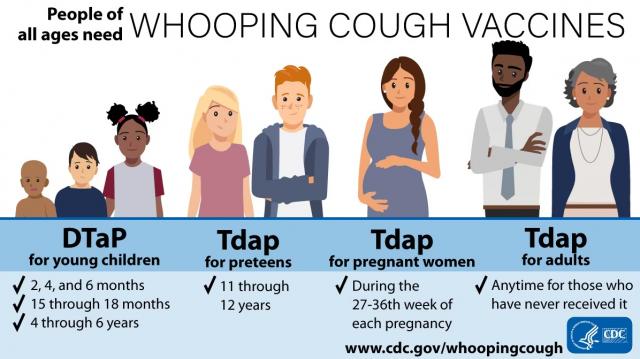Cases of whooping cough are on the rise in the United States, returning to pre-pandemic levels, according to the Centers for Disease Control and Prevention.
The CDC reports, as of June 1, reported cases are twice as high as they were last year. The increase is likely due to a return to social activities, like in-person gatherings, that slowed during the COVID-19 pandemic.
“With all the measures we took to prevent the transmission of COVID, we saw all sorts of respiratory illnesses go down significantly. Most of them have rebounded to where they were before as we have gotten back to our normal lives and aren’t wearing masks in public places nearly as much as we were before,” explained Dr. Zach Willis, an infectious disease specialist at UNC Children’s.
Staying up-to-date on DTaP and Tdap vaccines, staying away from others when you’re ill and practicing good hygiene can all help prevent the spread of whooping cough and other respiratory diseases.
What is whooping cough?
Whooping cough, also known as pertussis, is a highly contagious respiratory disease. It is named for the “whoop” noise heard when someone gasps for air after a coughing fit that affects about one-third of those with whooping cough.
The infection is very contagious, spread by coughing or sneezing while in close contact with others who breathe in the virus.
“There is one group of people that can get really sick with pertussis, and that’s infants,” Willis said. “Young infants under 6 months of age, if they get pertussis, they are at risk to get severe pneumonia that can put them in the hospital in the ICU.
“Most people who get sick with pertussis will have a few days of what feels like a normal cold with a runny nose and stuffy nose and then they’ll develop a cough.”
Willis said those infected with whooping cough can spread it for around 21 days, which is longer than the infectious period of flu or COVID. He recommends anyone who is feeling symptoms, even if mild, be tested. Antibiotics can reduce the infectious period sometimes down to just five days, reducing symptoms and your risk of spreading the disease.
Whooping cough: Who is most at risk?
It’s especially important for pregnant women to get the Tdap vaccine (which protects against tetanus, diphtheria, and pertussis) early in the third trimester to protect their newborn babies.
“Pertussis vaccines are part of routine infant schedules,” Willis said. “There are three doses for an infant, there’s a toddler dose and there’s additional booster doses at around 4-6 years, then another dose at 11-12 years that all children should be receiving.
“People who are unvaccinated really do have a much higher risk of getting an illness like pertussis and spreading it to others in their community.”
What to know about the whooping cough vaccine
People of all ages should get vaccines that protect against whooping cough.
Babies and children younger than seven years old receive DTaP vaccine, while older children and adults receive Tdap vaccine. CDC recommends whooping cough vaccination for all pregnant women, babies, children, preteens and adults.
Women should receive the Tdap vaccine between week 27 and 36 of pregnancy. Tdap vaccination during pregnancy protects nine in 10 babies from being hospitalized with whooping cough, according to the CDC.
How often to get a Tdap vaccine?
For older children and adults, the CDC recommends the Tdap vaccine. Adults who have never received Tdap should get a dose of Tdap and should receive a booster dose at least every 10 years.
For infants and children under 7 years old, the CDC recommends five doses of the DTaP vaccine at 2, 4, and 6 months, and again at 15–18 months and 4–6 years.
Both vaccines protect against tetanus, diphtheria and pertussis.
How to prevent whooping cough
The CDC lists the following recommendations to prevent pertussis and other infections:
- Practicing good hygiene, such as washing your hands often with soap and water, avoiding touching your face with unwashed hands, and cleaning and disinfecting frequently touched surfaces
- Covering coughs and sneezes with a tissue or upper shirt sleeve, not your hands
- Staying home when you’re sick
- Avoiding close contact with people who are sick
- If you’re an older adult with a cough, avoid contact with infants and children until you’re better

